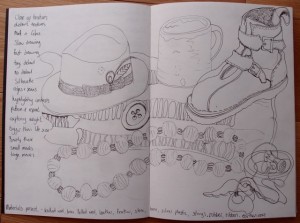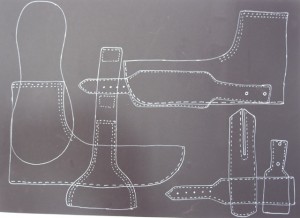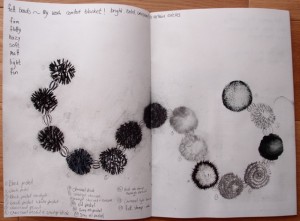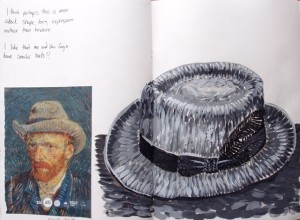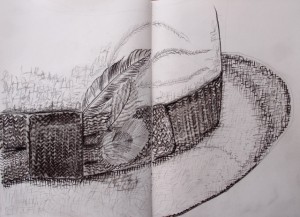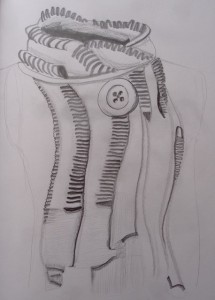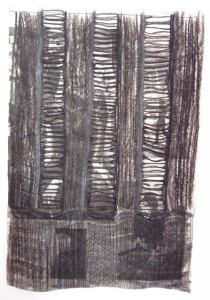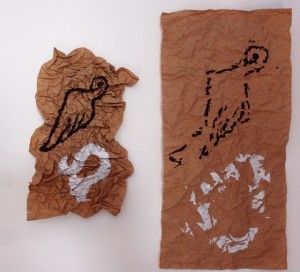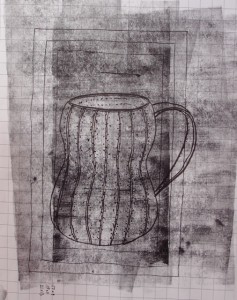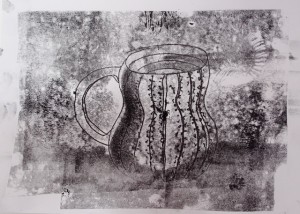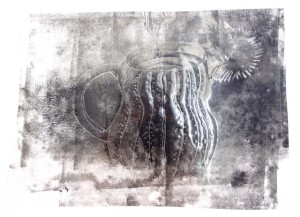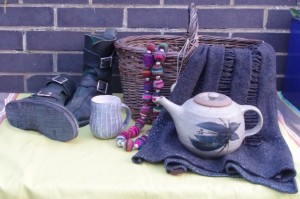Overall Comments
Linda you have made a really positive start to this new course with a rich body of work. It demonstrates your skill in drawing and an ability to use mark making to explore texture, composition and form. You have done some very interesting and relevant research during this assignment and used it appropriately to inspire your own creativity. The written work in your learning log is articulate and reflective.
This is really reassuring to read. It was a big decision to change to the new course but this makes me feel that I am approaching it in the right way. I am very much enjoying the tasks and the way they are delivered, I think that I have felt more confident about my work and this has shown in my drawings.
Feedback on assignment
Demonstration of technical and Visual Skills, Quality of Outcome, Demonstration of Creativity
For this first assignment in A Textiles Vocabulary you have used the Style Lounge theme to develop a group of drawings. You started this work really positively by creating mind maps of the different themes, organising your ideas so you could make a choice of which to use. I like how you made Lounge Style personal, understanding that through this you would get more from the exercise. Your initial drawing is nicely executed, then successfully going onto explore the items further in a range of mediums and on different surfaces. This way of drawing and redrawing in different ways is an excellent process to go through. It helps you to see what is there and focus on what excites you. I particularly like they way you have done this with the necklace you drew – exploring the felt beads each with a different medium. This has given you a range of results in one place, presenting you with the opportunity to compare and analyse the effect produced by each medium. I also like the group of drawings of the cup, using print techniques to create surface texture, tone and imagery. They have a nice loose exploratory style with an understanding of placement and composition. I am pleased to see that you have included the plastic print surface you used. These items are often very interesting and have a unique value that should be appreciated. For me your strongest work is where you have used the sole of your shoe to create surface texture and meaning. There is evidence here that you have also problem solved by transferring the texture of the sole to a printing foam in order to achieve more definition in the print. The drawing that is most successful is where you have used added the chevron print and collage. There is a balance to the composition with the positive and negative shoe prints and the enlarged chevron shape in both 2 and 3 dimensions.
I was really excited about my cup drawings – interestingly they were also some of the quickest drawings that I produced so I’m really pleased that they were highlighted, I am beginning to realise that ‘drawing’ is so much more than trying to create an exact image and I must try to keep this in mind. I wasn’t so confident about the shoe prints so this gives me the courage to experiment with ways of working, I do like adding 3D elements, the drawing with added print was a playful process. I now have license to play more!!
I suggest you continue to use drawing to explore the visual world using a range of techniques and media. This will ensure you continue to build your skill base and the development of your own style.
I certainly will!
Learning Logs or Blogs/Critical essays
Context
You have made a good start to your learning log and well done for choosing an online platform. You have included some interesting research material and responded to it well. The research you collected whist in France is particularly interesting. I can see how you have made links with your own work in the responses you have made. This is excellent. I suggest that you continue to respond to the work of others you have seen and enjoy. This will help you to develop your own style and understanding of what you want to see in your own outcomes. You have included a good number of photographs from this exhibition and added your own analysis of the work.
I am loving that my creative net is widening, and I’m trying to capture the tenuous links that I am making in my mind. Whilst wandering around I’m starting to have marvellous thoughts! It is clear to me that research isn’t research unless it is recorded so it is a priority for me to make more of an effort to record my findings and thinkings in a variety of ways.
You have included in your learning log a reflective commentary of your own work. This is articulate and revealing of how you think and understand your own creative process. It would be nice to see more of the photographs you describe in your learning log. There is some interesting writing about how you worked through putting together your still life. Changing it to create something useful and pleasing. It would be helpful to see the process you went through including the arrangements you discarded. This not only helps the assessors see what you have learnt but also makes it clear to you why some compositions work and others don’t.
This is my stumbling block- recording things. My tech capability doesn’t yet keep up with me. Practice, practice, practice….
Your learning log at present is a little difficult to navigate and may become more so as you add more work. I suggest divide the work into assignments and label accordingly. This will ensure that the assessors and myself will find each assignment quickly and simply.
I have struggled to set up the blog and have not yet developed a good working practice. I think at the moment my blog is a real bare bones sort of document. I have planned to make it future proof by not setting it up on the free wordpress site. Theoretically this will enable me to have more space for photos etc. I hope to make a clearer structure and also add links to my flikr and pintrest sites.
I suggest you continue to include research material from a wide range of places including exhibitions. Writing about what you see and what this means to you. Add more imagery of your own work to include the processes you go through in order to reveal your creative pathway to both your self and oca staff. Continue to reflect on what you make and what you think about it.
Suggested reading/viewing
Context
I suggest you continue to use the recommended and further reading lists, along with the lists of journals and useful websites to expand your research. Documenting what you find in your learning log.
To continue the development of your drawing I suggest you look at –
Maslen, M. & Southern, J. (2014) Drawing Projects: an exploration of the language of drawing. Published by Black Dog
Pointers for the next assignment
- Maintain you excellent working practices.
- Draw regularly in a range of mediums.
- Organise your learning log a little better to enhance navigation.
- Continue to research widely responding to what you see in your learning log.
- Add more photographs of your work and how you work to your learning log, reflecting on the outcomes.
